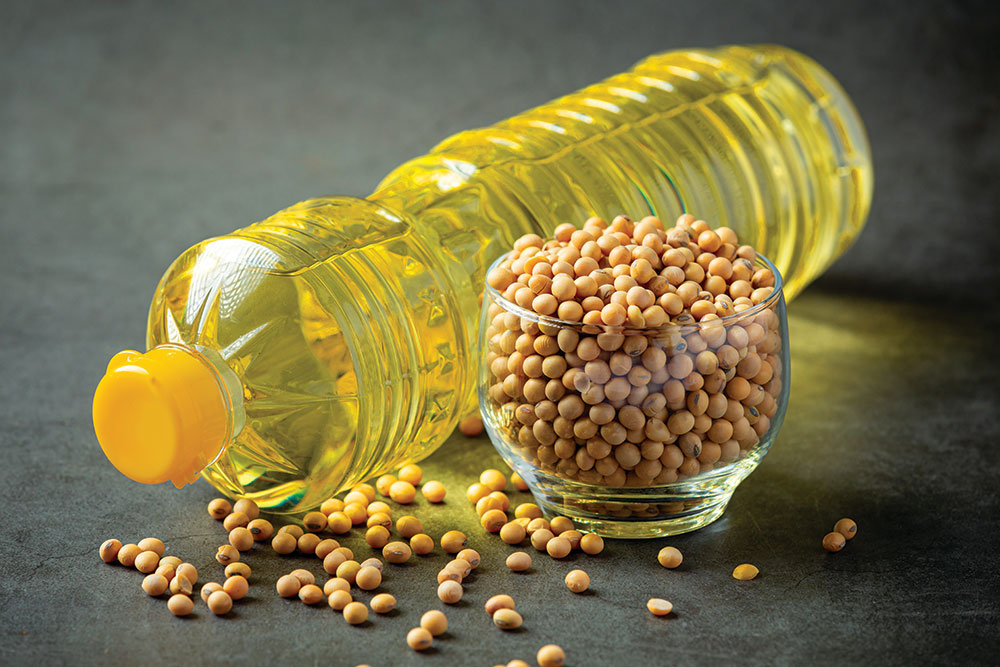India’s demand for edible oils far outweigh its production. While domestic consumption is around 25 MT, domestic production is only 11.16 MT. This leaves a demand and supply gap of about 56 percent, and therefore needs to be met through imports.
India is the largest importer of vegetable oils followed by China and USA. Of all the imported edible oils, the share of palm oil is about 60 percent at around 15 Metric Ton (MT), followed by soyabean oil with a share of 25 percent at around 3.5 Metric Ton (MT) and sunflower at 12 percent with about 2.5 Metric Ton (MT).
| Imported Edible Oils (Qty in MT) | ||||
|---|---|---|---|---|
| Sr No | Liquid Cargo | 2018-19 | 2019-20 | 2020-21 |
| 1 | Crude Palm oil | 6 | 6.8 | 7.5 |
| 2 | RBD Palmolein | 2.8 | 00.43 | 0.85 |
| 3 | Palm Oil | 9.34 | 7.25 | 8.31 |
| 4 | Crude soyabean oil | 3.12 | 3.40 | 2.90 |
| 5 | Crude sunflower | 2.34 | 2.5 | 2.00 |
| 6 | Crude Rapeseed | 0.06 | 0.02 | 0.05 |
| 7 | Crude Palm Kernel | 0.07 | 0.01 | 0 |
| 8 | Others | 0.54 | 0.14 | 0.29 |
- Impact on the sunflower oil industry in Ukraine
In Ukraine, sunflower seeds are sown in April and May, and harvesting usually begins in September. Tensions and military action in agricultural areas pose risks to the supply and demand of the next growing cycle. With trading routes being blocked, import-export facilities shutdown, and farmers unable to plant, the average yield per hectare of sunflower seeds will take a major blow this harvesting season.
Due to its focus on the export market, most Ukrainian crushing plants are logistically located near Black Sea ports and are often located away from the seed-growing areas of the central and eastern parts of the country. The invasion has rendered Ukrainian crushing plants inoperable. With the suspension of trading, and the absence of sunflower seeds, most sunflower oil production plants are completely closed. Coupled with the closure of major ports, major sunflower oil importers are now worried about procuring their supplies.
Approximately 300,000 ton of Ukrainian sunflower oil was scheduled to be shipped in late February and March, but due to the ongoing crisis, destination markets will be required to replace these quantities with edible oils available from other sources. The closure of sunflower oil production plants and shipping facilities has also adversely impacted the edible oil packaging industry in Ukraine.
- Current situation of sunflower oil in India
The ongoing Ukraine-Russia conflict has disrupted India’s edible oil market which gets more than 90 percent of its sunflower oil from these two countries. From November 2021 to February 2022, India imported 843,377 ton of sunflower oil, about 85 percent of which came from Ukraine, 14.3 percent from Russia and the rest from Argentina. India typically imports 150,000-200,000 ton of sunflower oil each month, according to industry experts. And while the conflict has impeded fresh imports, February imports were down by at least 70,000 ton.
| Sunflower import via major Indian ports (2020 - 21) (000;MT) | ||||
|---|---|---|---|---|
| PORTS | ARGENTINA | BRAZIL | RUSSIA | UKRAINE |
| CHENNAI | 21,000 | 17,000 | 292,178 | |
| HALDIA | 23,639 | 67,215 | ||
| HAZIRA | 8,000 | 13,750 | ||
| JNPT | 20,300 | 38,055 | 330,944 | |
| KAKINADA | 39,742 | 433,653 | ||
| KANDLA | 6,000 | 13,400 | 19,400 | |
| KRISHNAPATNAM | 11,000 | 15,000 | 168,252 | |
| MANGALORE | 15,000 | 18,461 | 162,059 | |
| MUNDRA | 34,350 | |||
| TUTICORIN | 36,778 | 16,843 | 13,723 | |
| Grand Total | 128,820 | 21,000 | 150,398 | 1,516,124 |
- Price outlook for sunflower oil
After just a few days of conflict, the commodity market faltered and the price of sunflower oil Free on Board (FOB) the Black Sea Ukraine, shot up by US $ 470.50 from US $ 1480 per metic ton, finally setting at around $ 1,950.50 Per metric ton. This is the highest that sunflower oil FOB the Black Sea has reached since 2018.
- Supply constraints and domestic supply
India usually imports about 175,000 -200,000 ton of sunflower oil per month. The conflict between Russia and Ukraine has disrupted sunflower oil supply. In Feb ’22, about 152,000 ton arrived in India and similar quantities arrived in March’22, as vessels which left before the war, arrived at Indian ports. The continuation of the war will lead to a decline of shipments which will get exacerbated over the months. To further compound the challenge, is the announcement of Indonesia tightening global export supplies, on palm oil. These two factors have led to high volatility in edible oil prices in the international market. However, the shortfall of sunflower oil availability is being met through higher domestic availability of soybean and mustard oils.
- The road ahead
India is looking to sign long-term contracts with Mercosur countries - Argentina, Brazil, Paraguay, and Uruguay, to import crude sunflower oil as Russia’s invasion of Ukraine has disrupted imports from Europe’s second-largest nation, leading to skyrocketing edible oil prices to Cost, Insurance and Freight (CIF) USD 2150 per metic ton. To combat this, India may need to reduce the import duty on sunflower oil originating from Mercosur countries and do away with the stringent testing requirements under the existing Preferential Tariff Agreement (PTA) with the grouping.
